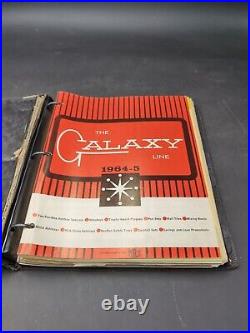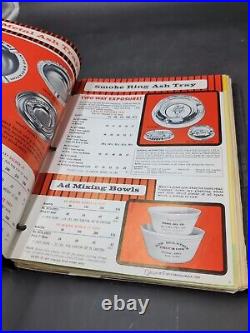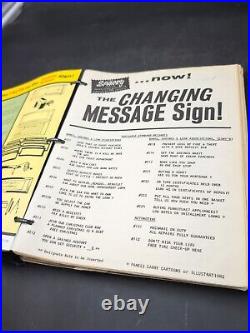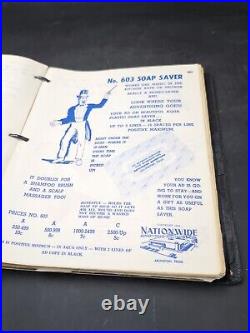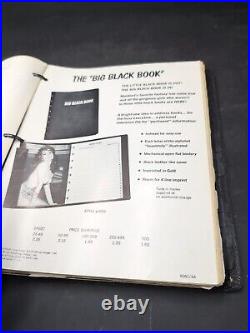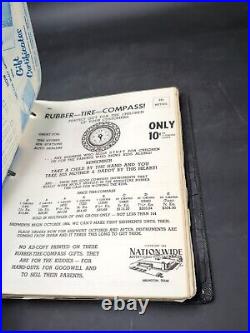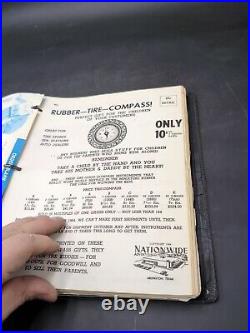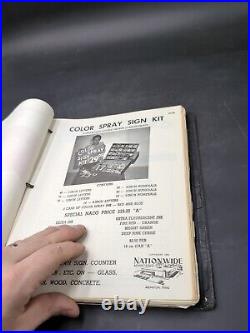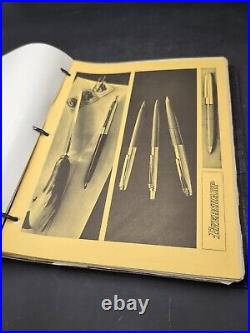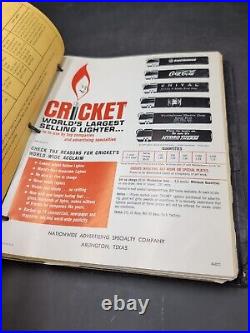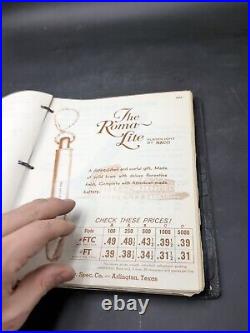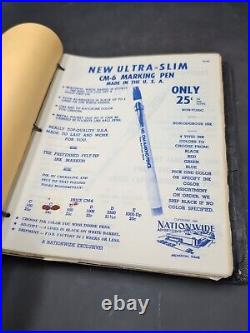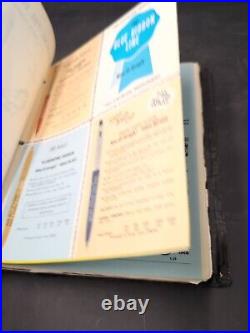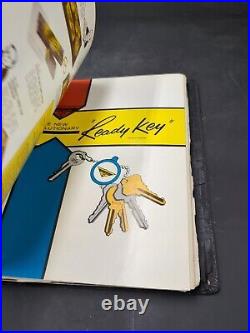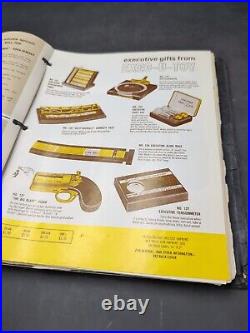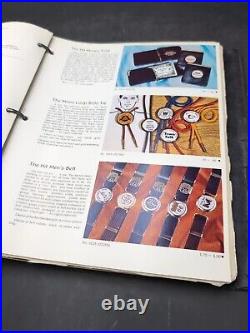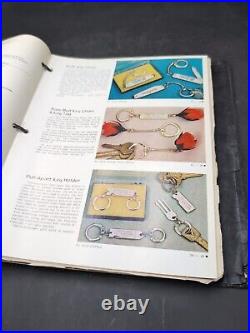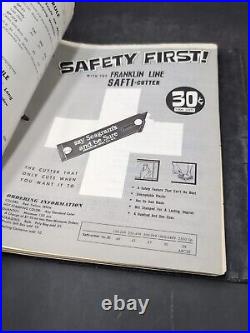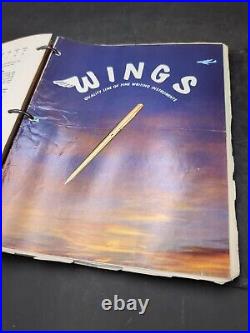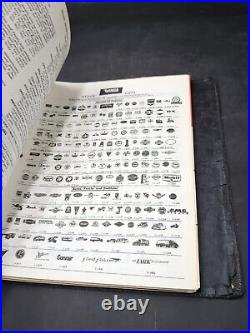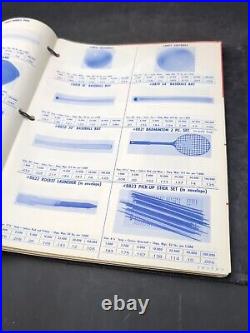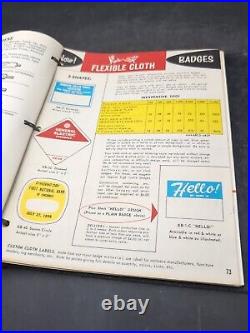Tag: catalogs
RARE 2 Vintage Advertising Catalogs Antique Dealer Brochures JEEP TRUCKS 1947
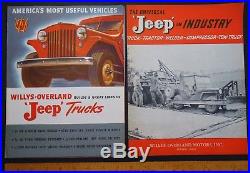
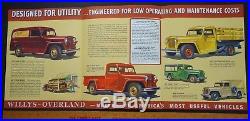
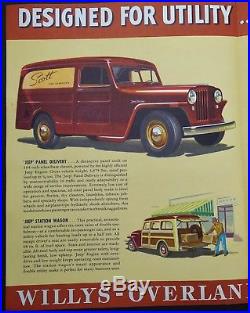
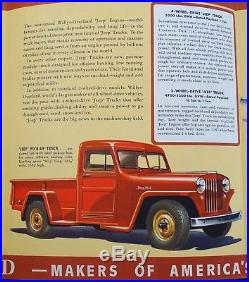
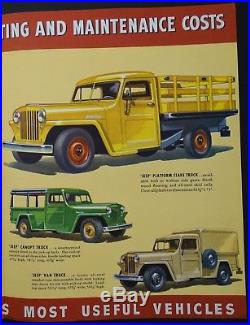
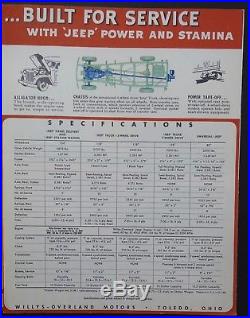
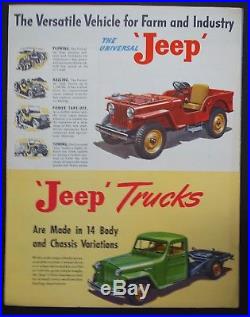
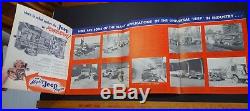
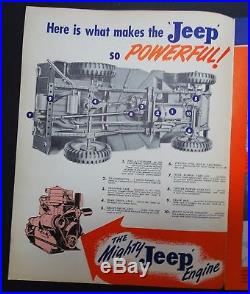
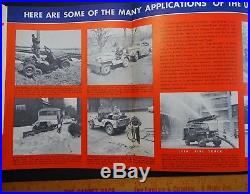
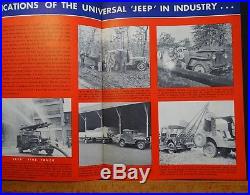
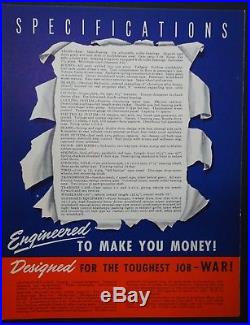

NICE Old Brochure / Catalog LOT. 2 – Fold out – Lg Brochures. Universal Jeep in Industry – welder, etc. For offer, a nice old lot of advertising ephemera. Fresh from an estate in Upstate New York. Never offered on the market until now. Vintage, Old, antique, Original – NOT Reproductions – Guaranteed!! Each one folds out – like a poster. Various models – great illustrations – color. The Universal jeep a truck, tractor, welder, compressor, two truck – with plow. In good to very good condition. Second one has part of bottom edge fold separation, rip. Please see photos for details. If you collect Americana history, 20th century American advertisement ad, automobile truck, WWII era, invention, machine, etc. This is one you will not see again soon. A nice piece for your paper / ephemera collection. The Willys Jeep Truck is a truck made by Willys-Overland Motors from 1947 to 1965. The styling and engineering of the Jeep Truck was based on Willys’ existing vehicles, the Willys Jeep Station Wagon and the Jeep CJ-2A. The Jeep Truck was introduced in 1947 as a 1-ton four-wheel drive truck with a wheelbase of 118 inches (2,997 mm). A ¾-ton two-wheel drive version became available by 1949. The truck was restyled in 1950 with the addition of a V-shaped grill with five horizontal bars. In 1951 the Hurricane IOE four cylinder engine replaced the earlier flathead engine, increasing power from 63 horsepower (47 kW) to 72 horsepower (54 kW). Optional accessories included an engine governor, a power takeoff, and a pulley drive. [2] A “Dump-O-Matic” hydraulic hoist became available for 1957. Over 200,000 of these trucks were manufactured. This section does not cite any sources. Please help improve this section by adding citations to reliable sources. Unsourced material may be challenged and removed. (January 2015) (Learn how and when to remove this template message). Final drive ratio (standard). Final drive ratio (optional). V-shaped grill with five horizontal bars. Four-wheel drive only from 1951 on. Two-wheel drive half-ton version of the 473. Restyled 473; three horizontal bars on grill instead of five. Replacement for 6-226; newer straight-six engine. 134 cu in (2.2 L). 226 cu in (3.7 L). 230 cu in (3.8 L). The Jeep Truck was available with only one transmission, the Borg-Warner T-90 three-speed manual, with synchromeshed second and third gears. A Spicer/Dana 18 transfer case was used on four-wheel drive models. The heavy duty Timken 51540 was used in the early years of production, later being replaced by the Dana 53. The front axle was a Dana 25. Jeep is a brand of American automobiles that is a division of FCA US LLC (formerly Chrysler Group, LLC), a wholly owned subsidiary of Fiat Chrysler Automobiles. [2][3] Jeep has been a part of Chrysler since 1987, when Chrysler acquired the Jeep brand, along with remaining assets, from its previous owner: American Motors Corporation (AMC). During the first half of 2017. [7] In the U. Prior to 1940 the term “jeep” had been used as U. Army slang for new recruits or vehicles, [8][9] but the World War II “jeep” that went into production in 1941 specifically tied the name to this light military 4×4, arguably making them the oldest four-wheel drive mass-production vehicles now known as SUVs. [10] The Jeep became the primary light 4-wheel-drive vehicle of the United States Army and the Allies during World War II, as well as the postwar period. The term became common worldwide in the wake of the war. Doug Stewart noted:[11] The spartan, cramped, and unstintingly functional jeep became the ubiquitous World War II four-wheeled personification of Yankee ingenuity and cocky, can-do determination. The Jeep marque has been headquartered in Toledo, Ohio, ever since Willys-Overland launched production of the first CJ or Civilian Jeep branded models there in 1945. [12] Its replacement, the conceptually consistent Jeep Wrangler series, remains in production since 1986. With its solid axles and open top, the Wrangler has been called the Jeep model that is as central to the brands identity as the rear-engined 911 is to Porsche. At least two Jeep models (the CJ-5 and the SJ Wagoneer) enjoyed extraordinary three-decade production runs of a single body generation. Jeeps have since the war inspired a number of other light utility vehicles, such as the Land Rover. [14][15] Many Jeep variants serving similar military and civilian roles have since been designed in other nations. In lowercase the term “jeep” continues to be used as a generic term for vehicles inspired by the Jeep that are suitable for use on rough terrain. World War II Jeeps. Main article: Willys MB. Dashboard of World War II era jeep. Jeep with 50 cal. When it became clear that the United States would be involved in the European theatre of World War II, the U. Army contacted 135 companies to create working prototypes of a four-wheel-drive reconnaissance car. Only two companies responded: American Bantam Car Company and Willys-Overland. The Army set a seemingly impossible deadline of 49 days to supply a working prototype. Willys asked for more time, but was refused. The broke American Bantam Car Company had only a skeleton staff left on the payroll and solicited Karl Probst, a talented freelance designer from Detroit. After turning down Bantam’s initial request, Probst responded to an Army request and began work on July 17, 1940, initially without salary. Probst laid out full plans for the Bantam prototype, known as the BRC or Bantam Reconnaissance Car, in just two days, working up a cost estimate the next day. [17] While much of the vehicle could be assembled from off-the-shelf automotive parts, custom four-wheel drivetrain components were to be supplied by Spicer. The hand-built prototype was completed in Butler, Pennsylvania, [18] and driven to Camp Holabird, Maryland, delivered for Army testing on September 23. The vehicle met all the Army’s criteria except engine torque. World War II had already begun in Asia, with Japan expanding in China, Manchuria and Southeast Asia. The Imperial Japanese Army used a small four-wheel-drive car for reconnaissance and troop movements, having introduced the Kurogane Type 95 in 1936. Enter Willys and Ford. The Army thought that the Bantam company was too small to supply the required number of vehicles, so it supplied the Bantam design to Willys and Ford, and encouraged them to modify the design. The resulting Ford “Pygmy” and Willys “Quad” prototypes looked very similar to the Bantam BRC prototype, and Spicer supplied very similar four-wheel drivetrain components to all three manufacturers. 1,500 of each model (Bantam BRC-40, Ford GP, and Willys MA) were built and extensively field-tested. After the weight specification was revised from 1,275 lb (578 kg) to a maximum of 2,450 lb (1,110 kg)[20] including oil and water, Willys-Overland’s chief engineer Delmar “Barney” Roos modified the design in order to use Willys’s heavy but powerful “Go Devil” engine, and won the initial production contract. The Willys version became the standard Jeep design, designated the model MB and was built at their plant in Toledo, Ohio. The familiar pressed-metal Jeep grille was a Ford design feature and incorporated in the final design by the Army. Because the US War Department required a large number of vehicles in a short time, Willys-Overland granted the US Government a non-exclusive license to allow another company to manufacture vehicles using Willys’ specifications. The Army chose Ford as a second supplier, building Jeeps to the Willys’ design. Willys supplied Ford with a complete set of plans and specifications. [21] American Bantam, the creators of the first Jeep, built approximately 2,700 of them to the BRC-40 design, but spent the rest of the war building heavy-duty trailers for the Army. Full production Willys MB and Ford GPW. Final production version Jeeps built by Willys-Overland were the Model MB, while those built by Ford were the Model GPW (G=government vehicle, P designated the 80 wheelbase, and W = the Willys engine design). There were subtle differences between the two. [22] The versions produced by Ford had every component (including bolt heads) marked with an “F”. Willys also followed the Ford pattern by stamping its name into some body parts, but stopped this in 1942. [24] Willys-Overland and Ford, under the direction of Charles E. Sorensen (Vice-President of Ford during World War II), produced about 640,000 Jeeps towards the war effort, which accounted for approximately 18% of all the wheeled military vehicles built in the U. Jeeps were used by every service of the U. An average of 145 were supplied to every Army infantry regiment. Jeeps were used for many purposes, including cable laying, saw milling, as firefighting pumpers, field ambulances, tractors and, with suitable wheels, would even run on railway tracks. An amphibious jeep, the model GPA, or “seep” (Sea Jeep) was built for Ford in modest numbers but it could not be considered a huge successit was neither a good off-road vehicle nor a good boat. As part of the war effort, nearly 30% of all Jeep production was supplied to Great Britain and to the Soviet Red Army. The Jeep has been widely imitated around the world, including in France by Delahaye and by Hotchkiss et Cie (after 1954, Hotchkiss manufactured Jeeps under license from Willys), and in Japan by Mitsubishi Motors and Toyota. The utilitarian good looks of the original Jeep have been hailed by industrial designers and museum curators alike. The Museum of Modern Art described the Jeep as a masterpiece of functionalist design, and has periodically exhibited the Jeep as part of its collection. [28][29] Ernie Pyle called the Jeep, along with the Coleman G. Pocket Stove, the two most important pieces of noncombat equipment ever developed. [30] Jeeps became even more famous following the war, as they became available on the surplus market. Some ads claimed to offer Jeeps still in the factory crate. The Jeepney is a unique type of taxi or bus created in the Philippines. The first Jeepneys were military-surplus MBs and GPWs, left behind in the war-ravaged country following World War II and Filipino independence. Jeepneys were built from Jeeps by lengthening and widening the rear “tub” of the vehicle, allowing them to carry more passengers. Over the years, Jeepneys have become the most ubiquitous symbol of the modern Philippines, even as they have been decorated in more elaborate and flamboyant styles by their owners. Most Jeepneys today are scratch-built by local manufacturers, using different powertrains. Some are even constructed from stainless steel. In the United States military, the Jeep has been supplanted by a number of vehicles e. Ford’s M151 of which the latest is the Humvee. After World War II, Jeep began to experiment with new designs, including a model that could drive under water. On February 1, 1950, contract N8ss-2660 was approved for 1,000 units “especially adapted for general reconnaissance or command communications” and constructed for short period underwater operation such as encountered in landing and fording operations. The engine was modified with a snorkel system so that the engine could properly breathe under water. In 1965, Jeep developed the M715 1.25-ton army truck, a militarized version of the civilian J-series Jeep truck, which served extensively in the Vietnam War. It had heavier full-floating axles and a foldable, vertical, flat windshield. Today, it serves other countries, and is still being produced by Kia under license. See also: Willys MB § How the jeep got its name. Many explanations of the origin of the word jeep have proven difficult to verify. The most widely held theory is that the military designation GP (for Government Purposes or General Purpose) was slurred into the word Jeep in the same way that the contemporary HMMWV (for High-Mobility Multi-purpose Wheeled Vehicle) has become known as the Humvee. Joe Frazer, Willys-Overland President from 1939 to 1944, claimed to have coined the word jeep by slurring the initials G. [33] There are no contemporaneous uses of “GP” before later attempts to create a backronym. A more detailed view, popularized by R. The Ford GPW abbreviation actually meant G for government use, P to designate its 80-inch (2,000 mm) wheelbase and W to indicate its Willys-Overland designed engine. Ermey suggests that soldiers at the time were so impressed with the new vehicles that they informally named it after Eugene the Jeep, a character in the Thimble Theatre comic strip and cartoons created by E. Segar, as early as mid-March 1936. Eugene the Jeep was Popeye’s “jungle pet” and was small, able to move between dimensions and could solve seemingly impossible problems. The word “jeep” however, was used as early as World War I, as US Army slang for new uninitiated recruits, or by mechanics to refer to new unproven vehicles. [8][9] In 1937, tractors which were supplied by Minneapolis Moline to the US Army were called jeeps. A precursor of the Boeing B-17 Flying Fortress was also referred to as the jeep. Words of the Fighting Forces by Clinton A. Sanders, a dictionary of military slang, published in 1942, in the library at The Pentagon gives this definition. Jeep: A four-wheel drive vehicle of one-half- to one-and-one-half-ton capacity for reconnaissance or other army duty. A term applied to the bantam-cars, and occasionally to other motor vehicles U. In the Air Corps, the Link Trainer; in the armored forces, the ½-ton command vehicle. Also referred to as any small plane, helicopter, or gadget. This definition is supported by the use of the term “jeep carrier” to refer to the Navy’s small escort carriers. Early in 1941, Willys-Overland demonstrated the vehicle’s off-road capability by having it drive up the steps of the United States Capitol, driven by Willys test driver Irving “Red” Hausmann, who had recently heard soldiers at Fort Holabird calling it a jeep. ” When asked by syndicated columnist Katharine Hillyer for the Washington Daily News (or by a bystander, according to another account) what it was called, Hausmann answered, “It’s a jeep. Katharine Hillyer’s article was published nationally on February 19, 1941, and included a picture of the vehicle with the caption. LAWMAKERS TAKE A RIDE- With Senator Meade, of New York, at the wheel, and Representative Thomas, of New Jersey, sitting beside him, one of the Army’s new scout cars, known as “jeeps” or “quads”, climbs up the Capitol steps in a demonstration yesterday. Soldiers in the rear seat for gunners were unperturbed. Although the term was also military slang for vehicles that were untried or untested, this exposure caused all other jeep references to fade, leaving the 4×4 with the name. Brand, trademarks and image. Willys wartime advertisement promoting its Jeeps’ contribution to the war effort. [1] To help establish the term as a Willys brand, the firm campaigned with advertisements emphasizing Willys’ prominent contribution to the Jeep that helped win the war. [1] Willys’ application initially met with years of opposition, primarily from Bantam, but also from Minneapolis-Moline. The Federal Trade Commission initially ruled in favor of Bantam in May 1943, largely ignoring Minneapolis-Moline’s claim, and continued to scold Willys-Overland after the war for its advertising. [37] The FTC even slapped the company with a formal complaint, to cease and desist any claims that it “created or designed” the Jeep Willys was only allowed to advertise its contribution to the jeep’s development. [38] Willys however proceeded to produce the first Civilian Jeep (CJ) branded vehicles in 1945, and simply copyrighted the Jeep name in 1946. The original 9-slot grille associated with all World War II jeeps was designed by Ford for their GPW, and because it weighed less than the original “Slat Grille” of Willys (an arrangement of flat bars), was incorporated into the “standardized jeep” design. The history of the HMMWV (Humvee) has ties with Jeep. The General Motors Hummer and Chrysler Jeep have been waging battle in U. Courts over the right to use seven slots in their respective radiator grilles. Chrysler Jeep claims it has the exclusive rights to use the seven vertical slits since it is the sole remaining assignee of the various companies since Willys gave their postwar jeeps seven slots instead of Ford’s nine-slot design for the Jeep. Jeep advertising has always emphasized the brand’s vehicles’ off-road capabilities. [41] Today, the Wrangler is one of the few remaining four-wheel-drive vehicles with solid front and rear axles. These axles are known for their durability, strength, and articulation. New Wranglers come with a Dana 44 rear differential and a Dana 30 front differential. The upgraded Rubicon model of the JK Wrangler is equipped with electronically activated locking differentials, Dana 44 axles front and rear with 4.10 gears, a 4:1 transfer case, electronic sway bar disconnect and heavy duty suspension. Another benefit of solid axle vehicles is they tend to be easier and cheaper to “lift” with aftermarket suspension systems. This increases the distance between the axle and chassis of the vehicle. By increasing this distance, larger tires can be installed, which will increase the ground clearance, allowing it to traverse even larger and more difficult obstacles. In addition to higher ground clearance, many owners aim to increase suspension articulation or “flex” to give their Jeeps greatly improved off-road capabilities. Good suspension articulation keeps all four wheels in contact with the ground and maintains traction. Useful features of the smaller Jeeps are their short wheelbases, narrow frames, and ample approach, breakover, and departure angles, allowing them to fit into places where full-size four-wheel drives have difficulty. Company history and ownership. After the war, Willys did not resume production of its passenger-car models, choosing instead to concentrate on Jeeps and Jeep-branded vehicles, launching the Jeep Station Wagon in 1946, the Jeep Truck in 1947, and the Jeepster in 1948. [42] Kaiser initially called the merged company “Willys Motors”, but renamed itself Kaiser-Jeep in 1963. By the end of 1955, Kaiser-Frazer had dropped the Willys Aero, as well as its own passenger cars to sell Jeeps exclusively. [42] The utility vehicles complemented AMC’s passenger car business by sharing components, achieving volume efficiencies, as well as capitalizing on Jeep’s international and government markets. In 1976 Jeep introduced the CJ-7, replacing the CJ-6 in North America, as well as crossing 100,000 civilian units in annual global sales for the first time. The French automaker Renault began investing in AMC in 1979. During this period Jeep introduced the XJ Cherokee, its first unibody SUV; and global sales top 200,000 for the first time in 1985. [43] However, the replacement of the CJ Jeeps by the new Wrangler line in 1986 marked the start of a different era. By 1987, the automobile markets had changed and Renault itself was experiencing financial troubles. At the same time, Chrysler Corporation wanted to capture the Jeep brand, as well as other assets of AMC. So Chrysler bought out AMC in 1987, shortly after the Jeep CJ-7 had been replaced with the AMC-designed Wrangler YJ. After more than 40 years, the four-wheel drive utility vehicles brand that had been a profitable niche for smaller automakers, fell into the hands of one of the Big Three; and Jeep was the only AMC brand continued by Chrysler after the acquisition. But Chrysler subsequently merged with Daimler-Benz in 1998 and folded into DaimlerChrysler. Chrysler and the Jeep division operated under Chrysler Group LLC, until December 15, 2014, when Chrysler folded into Fiat Chrysler Automobiles, with the stateside division operating under’FCA US LLC’. Jeeps have been built under licence by various manufacturers around the world, including Mahindra in India, EBRO in Spain, and several in South America. Mitsubishi built more than 30 models in Japan between 1953 and 1998. Most were based on the CJ-3B model of the original Willys-Kaiser design. Toledo, Ohio has been the headquarters of the Jeep brand since its inception, and the city has always been proud of this heritage. Although no longer produced in the same Toledo Complex as the World War II originals, two streets in the vicinity of the old plant are named Willys Parkway and Jeep Parkway. The Jeep Wrangler and Jeep Cherokee are built in the city currently, in separate facilities, not far from the site of the original Willys-Overland plant. American Motors set up the first automobile-manufacturing joint venture in the People’s Republic of China on January 15, 1984. [45] The result was Beijing Jeep Corporation, Ltd. In partnership with Beijing Automobile Industry Corporation, to produce the Jeep Cherokee (XJ) in Beijing. Manufacture continued after Chrysler’s buyout of AMC. This joint venture is now part of DaimlerChrysler and DaimlerChrysler China Invest Corporation. The original 1984 XJ model was updated and called the “Jeep 2500″ toward the end of its production that ended after 2005. While Jeeps have been built in India under licence by Mahindra & Mahindra since the 1960s, Jeep has entered the Indian market directly in 2016, starting with release of the Wrangler and Grand Cherokee in the country. 19531964: Kaiser-Jeep (calling themselves “Willys Motors”). 19701987: AMC (w/ Renault controlling production in 1986). 20092013: Chrysler Group LLC – Fiat Group Automobiles. 2014present: Fiat Chrysler Automobiles. Military Jeeps model list. This section may be too long and excessively detailed. Please consider summarizing the material while citing sources as needed. Main article: List of U. World War II era jeep built by Ford, using the Willys-Overland design. 1942 Willys MB (slat grille). 19421945 Willys MB (stamped grille). 1943 Willys WAC (for’Willys Air Cooled’) “Jeeplet” prototype for a super light-weight, fulltime 4WD with front and rear independent suspension [48]. 1944 Willys MLW-1 (for’Military Long Wheelbase’) prototype (never finished). 1944 Willys MLW-2 (for’Military Long Wheelbase’) or “Jungle Jeep” prototype for a half-ton, jungle-suited jeep [48]. 1950 CJ V-35(/U) deep water fording CJ-3A; 1000 units built for the USMC [49]. World War II era Willys jeep. 19521957 M38A1C fitted with 105/106mm anti-tank recoilless rifle. 19561965 Jeep Forward Control (Military Variations). 19671969 Kaiser Jeep M715based upon the civilian Jeep Gladiator. Civilian Jeeps model list. Main article: List of Jeep vehicles. Main article: Jeep CJ (Civilian Jeep). The CJ (for “Civilian Jeep”) series were literally the first “Jeep” branded vehicles produced for the civilian public, beginning in 1945 with the CJ-2A, followed by the CJ-3A in 1949 and the CJ-3B in 1953. These early Jeeps are commonly referred to as “flatfenders” because their front fenders were flat and rectangular across, like on their military forebears, the Willys MB and identical Ford GPW models. The CJ-4 exists only as a 1951 prototype, and is the “missing link” between the flat-fendered CJ-2A and CJ-3B and the round-fendered CJ-5 first introduced in 1955. 19641967 CJ-5A/CJ-6A Tuxedo Park. Willys Jeep Station Wagon and Truck. The 19461965 Willys Jeep Station Wagon and the. 19471965 Willys Jeep Truck shared much in terms of styling and engineering. With over 300,000 wagons and its variants built in the U. It was one of Willys’ most successful post-World War II models. Its production coincided with consumers moving to the suburbs. Willys / Jeep Jeepster & (Jeepster) Commando. Main articles: Willys / Jeep Jeepster and Jeepster Commando. The 1948 introduced Jeepster was directly based on the rear-wheel-drive Jeep Station Wagon chassis, and shared many of the same parts. 19481950 Willys VJ Jeepster[53]. Hurst Jeepster (only 100 produced). Main article: Jeep Forward Control. The 19561965 Jeep Forward Control was built in both civilian and military models. The civilian versions were. Jeep DJ and Fleetvan. Main articles: Jeep DJ (Dispatcher Jeep) and Fleetvan. From 1955 onwards Willys offered two-wheel drive versions of their CJ Jeeps for commercial use, called DJ models (for’Dispatcher Jeep’), in both open and closed body-styles. A well-known version was the right-hand drive model with sliding side-doors, used by the US Postal service. SJ Wagoneer, Cherokee and pickups. Main article: Jeep SJ (aka Full Size Jeep). 19661969 SJ Super Wagoneer. 19841991 SJ Grand Wagoneer. Jeep Cherokee (XJ) and Comanche. Main articles: Jeep Cherokee (XJ) and Jeep Comanche. 19861992 Jeep Comanche (MJ). 1989 Jeep Wrangler YJ Islander. Main article: Jeep Wrangler. 19871995 Jeep Wrangler YJ. 1995 Wrangler Rio Grande. 1997 Jeep Wrangler TJ. 2002 TJ Se, X, Sport, Sahara models. 2003 TJ Rubicon, Rubicon Tomb Raider Edition, Sahara, Sport, X, Se models, Freedom Edition. 20042006 TJ Long Wheel Base (LJ) Unlimited(15 Longer than a standard TJ) Rubicon, Sport, X, Se models. 20042005 Willys Edition (20041997 made, 20052001 made). 2005 Rubicon Sahara Unlimited TJ LWB (LJ) (1000 made). 2006 Golden Eagle Edition, 65 Year Anniversary Edition (1,675 Black 65th Anniversary Editions made). 2016 Jeep Wrangler Unlimited (MIAS’16). 20072009 JK Rubicon, Sahara, X. 2010 JK Rubicon, Sahara, Mountain, Islander, Sport. 2011 Oscar Mike Military Edition (200 made)[54]. 2011 Call of Duty: Black Ops Edition. 2011 70th Anniversary Edition. 2013 Rubicon 10th Anniversary Edition. 2014 Willys Wheeler Edition. 2017 Jeep Wrangler JL. Main article: Jeep Grand Cherokee. 19931998 Grand Cherokee ZJ. 19951997 Orvis “Limited Edition”. 1998 5.9 Limited. 1993 ZJ Jeep Grand Wagoneer. 19992004 Grand Cherokee WJ Grand Cherokee. 2011 present Jeep Grand Cherokee WK2. Jeep Liberty / Cherokee. Main article: Jeep Liberty. 20022007 Jeep Liberty KJ or Jeep Cherokee (KJ) outside North America. 200405 Rocky Mountain Edition. 2006 65th Anniversary Edition. 2007 Latitude Edition(replaced Renegade). 20082012 Jeep Liberty KK or Jeep Cherokee (KK) outside North America. 20062010 Jeep Commander (XK). Jeep Compass and Patriot platform. Main articles: Jeep Compass and Jeep Patriot. 20072017 Jeep Compass MK49. 2017present Jeep Compass MP/552. 1949 Alcoa Aluminum-bodied Jeepster Coupe (prototype)[56]. 1949/1950 X-98 prototype; with flat fenders, but a rounded hood and grille like the CJ-5, it may have been the first F-head-powered Jeep[57]. 1952 CJ Coiler: experimental design for an all independent suspension, with portal-hub swing-axles and coil-springs [48]. 1958 Jeep Creep: prototype utility vehicle; several versions built for tests, including a Postal rig and an aircraft tug [48]. 1959 Jeep J-100 Malibu and Berkeley: Later developed into the Wagoneer [48]. 1960 Jeep Wide-Trac: Concept for developing a low-cost vehicle for third-world countries. 1962 The Brazilian Jeepster (prototype)[58][59]. 1963 Jeep XM-200: J200 based concept for developing a low-cost vehicle for third-world countries [48]. 1965 Jeep/Renault Model H: A light 4×4 prototype based on the Renault 16. 1966 FWD Concept Jeepvair: Similar to the Model H but with a Chevrolet Corvair powertrain. 1971 Jeep Cowboy: A design study using AMC’s “compact” automobile platform[60]. 1979 Jeep Jeepster II. 1986 Cherokee Targa: A two-door Cherokee convertible (later revised as Jeep Freedom show car). 1987 Comanche Thunderchief: This vehicle was put into production later as the Comanche Eliminator. 1989 Jeep Concept 1: Evolved into the ZJ Grand Cherokee. 1989 Jeep Rubicon Wrangler: This vehicle was later put in production. 1990 Jeep JJ: Essentially what would later be called the Icon. 1990 Jeep Freedom:[61] A revised Cherokee Targa. 1991 Jeep Wagoneer 2000: A design study be the next generation Wagoneer, but was not put into production. 1997 Jeep Cherokee Casablanca: A special edition of Cherokee, never produced. 1997 Jeep Wrangler Ultimate Rescue: A tuned version of a regular TJ Wrangler developed for SEMA show. 1997 Fender Jeep Wrangler. 1997 Jeep Dakar: A fused version of a XJ Cherokee and TJ Wrangler. 1997 Jeep Icon: A design study for the next-generation Wrangler. 1999 Jeep Jeepster Concept. 2000 Jeep Cherokee Total Exposure. 2000 Jeep Varsity: Subsequently, put into production as the Compass. 2000 Jeep Commander Concept: Subsequently, put into production as the XK. 2002 Jeep Wrangler Tabasco. 2002 Jeep Wrangler Patriot: A special decal package for the Wrangler X/Sport. 2002 Jeep Wrangler Mountain Biker. 2004 Jeep Grand Cherokee (WJ) Concierge. 2004 Jeep Liberator CRD. 2005 Jeep Hurricane: The 4-wheel steering system allows the vehicle to have both a zero turning circle, and “crab” sideways. [62] Its engine was later put in the Grand Cherokee (WK) SRT-8. 2005 Jeep Gladiator Concept. 2005 Jeep Aggressor (the Rezo). 2010 Jeep Nukizer: Design study inspired by the Military Kaiser M-715. 2011 Jeep Wrangler JK-8 Independence: taking cues from the 1980s Scrambler CJ-8. 2011 Jeep Wrangler Pork Chop. 2011 Jeep Compass Canyon: uses a 2 1/8 inch lift. 2011 Jeep Cherokee Overland. 2013 Jeep Wrangler Mopar Recon. 2013 Jeep Grand Cherokee Trailhawk EcoDiesel. 2013 Jeep Wrangler Stitch. 2013 Jeep Wrangler Flattop: featuring a one-piece, windowless hardtop. 2014 Jeep Wrangler Level Red. 2014 Jeep Cherokee Dakar. 2014 Jeep Wrangler MOJO. 2015 Jeep Wrangler Africa. 2015 Jeep Wrangler Red Rock Responder. 2015 Jeep Staff Car: a tribute to Jeep’s military history starting with WWII. The Jeep brand currently produces five models, but 8 vehicles are under the brand name or use the Jeep logo. Jeep Renegade BU: Subcompact Sport Utility Vehicle. JK: Standard wheelbase Compact Sport utility vehicle, 2-door version. JK Unlimited: Long wheelbase Mid-Size sport utility vehicle, 4-door version. J8: Mid-Size military sport utility vehicle; Produced by AIL, AAV, and AEV. JL: Short (2-door) and long (4-door) wheelbase SUV; in production since November 2017. Jeep Grand Cherokee: Mid-size sport utility vehicle. Jeep Compass: Compact sport utility vehicle. Jeep Cherokee KL: Mid-size sport utility vehicle. Jeep Wagoneer / Grand Wagoneer: Full-Size SUVs expected for 2021. Jeeps built outside the USA. Mahindra & Mahindra Limited Indian Jeep. Jeeps have been built and/or assembled around the world by various companies. Argentina IKA Jeeps 1956current; now owned by Chrysler[65]. Australia Willys Motors Australia 1940s1980s[66]. Burma/Myanmar Two Burmese companies produce unlicensed copies of jeeps; Myanmar Jeeps and Chin Dwin Star Jeeps. Canada Kaiser Jeep 19591969[68]. China Beijing Jeep Corporation 1983 to 2009 as Beijing-Benz DaimlerChrysler Automotive. Fiat-Chrysler plans to re-open Jeep production in China through joint venture with Guangzhou Automobile Industry Group (GAIG). Colombia Willys Colombia at least until 1999[70]. Egypt Arab Organization for Industrialization subsidiary Arab American Vehicles based in Cairo produces the Jeep Cherokee; the open-top, Wrangler-based Jeep AAV TJL. France Licence produced jeeps: Hotchkiss M201 and by Cournil (now Auverland) 19521962[71]. India Mahindra & Mahindra Limited 1960s-current[72]. Iran Pars Khodro, ShahBaaz, Sahra, and Ahoo ShahBaaz based on DJ series, Sahra based on Jeep Wrangler and CJ series, and Ahoo based on Wagoneer. Israel Automotive Industries which produces the AIL Storm (Sufa) series of Jeep Wrangler-derivatives. Japan Mitsubishi Jeeps 19531998[74]. Korea Asia Motors, Ltd, Dong A Motors (SsangYong Motor Company) and Kia. (don’t use Jeep name) 1980s-current[75]. Mexico VAM Jeeps 19461987[76]. Philippines Jeepneys;[78] MD Juan Willys MB. [79] “E-jeepneys” or minibuses, LSV (low-speed vehicles) which uses electricity. Portugal Bravia Sarl 1960s to 1980s This Lisbon company assembled a number of Kaiser Jeep M-201 models from several Spanish EBRO and VIASA parts built to order for the USAF airfields & the US Army based at the time in Portugal, of the 500 vehicles made, most had American running gear. Spain Vehículos Industriales y Agrícolas, S. Venezuela- Valencia Carabobo 19622011, 1962 Tejerias Edo Aragua Willys de Venezuela, S. A, 19792011 Ensambladora Carabobo C. A Valencia Edo Carabobo. Jeep apparel and sponsorships. It is reported that there are between 600 and 1,500 such outlets in China, vastly outnumbering the number of Jeep auto dealers in the country. In August 2014 Jeep signed a sponsorship deal with Greek football club AEK Athens F. AMC and Jeep transmissions. Criticism of sport utility vehicles. Jeep Jamboree: Off Road Adventure, a video game based on the then-current Jeep Wrangler YJ model. List of automobile manufacturers of the United States. The item “RARE 2 Vintage Advertising Catalogs Antique Dealer Brochures JEEP TRUCKS 1947″ is in sale since Tuesday, March 13, 2018. This item is in the category “Collectibles\Advertising\Automobiles\American\Jeep & Willys”. The seller is “dalebooks” and is located in Rochester, New York. This item can be shipped worldwide.
- Type of Advertising: Brochure
- Date of Creation: 1947
- Color: Red
- Original/Reproduction: Original
- Make: Jeep
- Date of Origin: 1947
- Country/Region of Manufacture: United States


